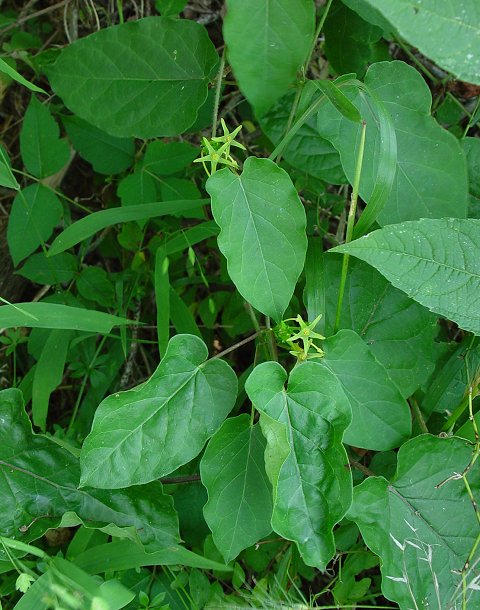Gonolobus suberosus (L.) R. Br.
Angle-Pod

Native
CC = 7
CW = -3
MOC = 13
© DETenaglia
Gonolobus suberosus (L.) R. Br.Angle-Pod | |
 |
Native CC = 7 CW = -3 MOC = 13 |
© DETenaglia |
|
Family - Asclepiadaceae Habit - Perennial forb with milky sap. Stems - Twining, usually climbing, to 3 m or more, herbaceous, branched or unbranched, sparsely to moderately pubescent with spreading hairs, usually also with sparse to moderate, minute glandular hairs, some with pustular bases.
Leaves - Opposite, simple, petiolate. Petioles to 10 cm, less pubescent than the stem, terete. Blades 4-20 cm long, oblong-ovate to triangular-ovate or broadly ovate, the base deeply cordate, the tip abruptly or gradually tapered to a sharp point, the margins flat and entire, sparsely short-hairy along the veins, usually also with sparse to moderate, minute glandular hairs.
Inflorescence - Axillary umbellate clusters of 2-25 flowers, sessile to long-stalked, sometimes branched. Pedicels sparsely short pubescent with the same hairs as the leaves, to 1.5 cm. Pedicels with small subulate bracts at the base (1 per pedicel). Bracts to 1.5 cm long, ciliate-margined.
Flowers - Calyces with the lobes 2.5-6.0 mm long, spreading at maturity, narrowly triangular to narrowly lanceolate, glabrous except for sparse, short hairs along the margins toward the tip. Corollas with the lobes 7-15 mm long, strongly spreading at flowering, narrowly lanceolate, yellow to yellowish green, glabrous. Gynostegium appearing sessile or nearly so, the corona present as a flattened, fleshy, irregularly 5-angled disc shorter than the anther/stigma head, yellow to orangish brown.
Fruit - Follicles 7-15 cm long, pendent, lanceolate to narrowly ovate in outline, sharply 5-angled in cross-section, the surface smooth, glabrous. Seeds with the body 6-10 mm long, elliptic-obovate in outline, strongly flattened and with a narrow to relatively broad, irregularly toothed wing, dark brown, with a tuft of long, white, silky hairs at the tip. Flowering - July - August. Habitat - Swamps, bottomland forests, lower ledges of bluffs, lake margins, sloughs, streambanks, disturbed wooded areas. Origin - Native to the U.S. Lookalikes - None. Other info. - This interesting milkweed sibling can be found in Missouri only in a few far southern counties. In fact, Missouri lies at the northern extreme of the plant's range, which extends southward to the Gulf Coast. It is relatively easy to identify in the field because of its big cordate leaves, vining habit, and greenish star-shaped flowers. Photographs taken in the Ozark National Scenic Riverways, Carter County, MO., 7-15-03 (DETenaglia); also at Markham Spring Recreation Area, Wayne County, MO6-24-2016, and near the Current River in Van Buren, Carter County, MO, 6-25-2016 (SRTurner). |